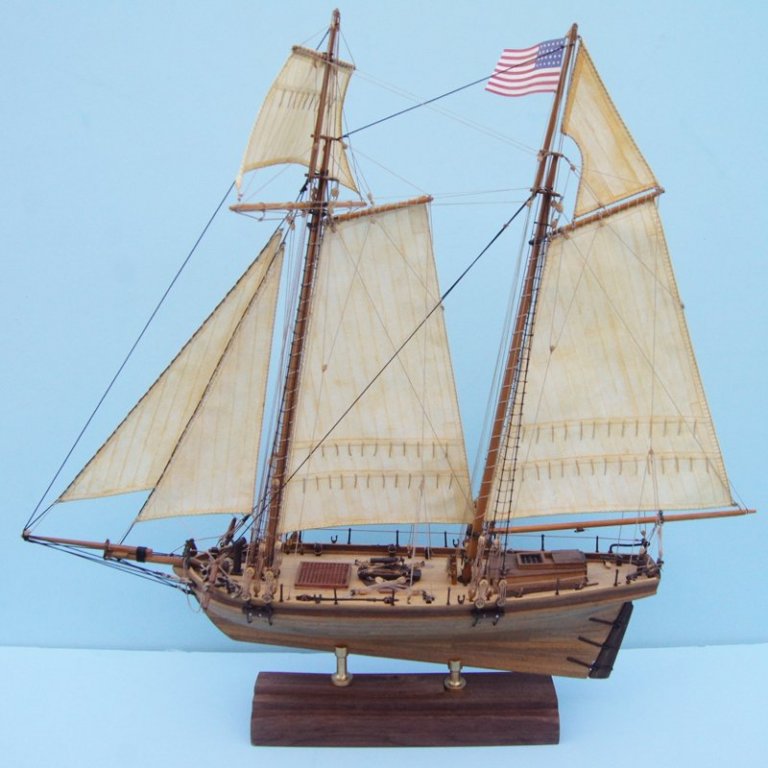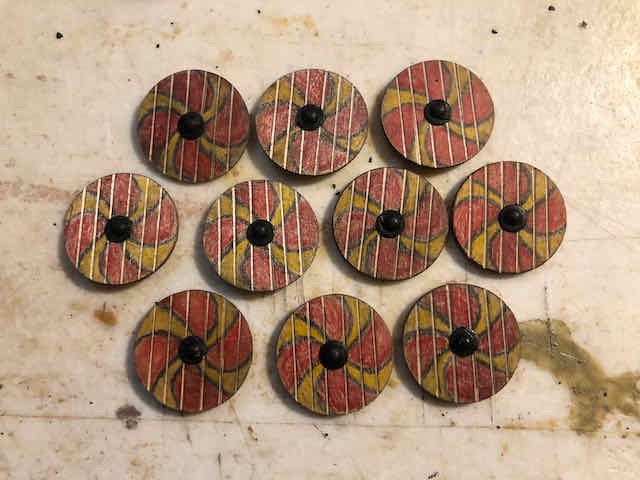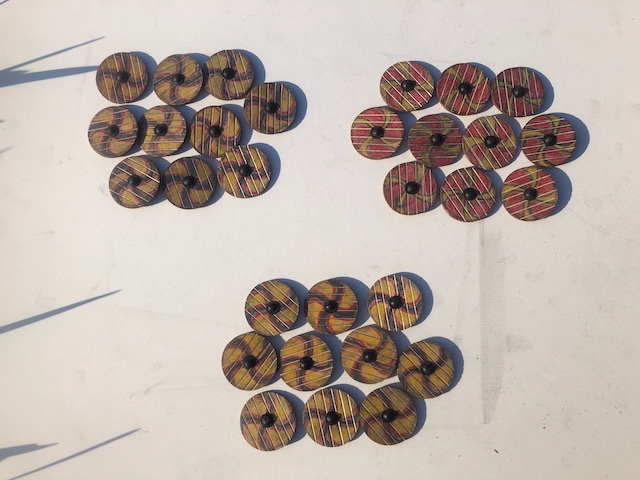-
Posts
3,489 -
Joined
-
Last visited
Content Type
Profiles
Forums
Gallery
Events
Everything posted by Cathead
-
What a fascinating and inspiring project. I'm so grateful you shared it.
- 95 replies
-
- POW
- Bone model
-
(and 2 more)
Tagged with:
-
How long have you been on the internet? Seriously, though, I've definitely been thinking about other details like barrels, sacks, etc. This was a warship, not a trading vessel like the one above, but it still would have carried stores for a voyage. So you may be right that I could mess around with shields layered over that stuff. So much to think about.
-
And look at those nice cross-hatched sails! This trading vessel has a small crew and only a few shields and weapons, I'm still not sure how a crew of 60+ would have stashed their gear in a secure but easy-to-deploy manner.
-
Jack, those are great photos, but the basic point is I didn't want to hang them off the gunwale, whether by lashing or shield rack, because they'd block the oars. Looking closely, it seems like your vessel actually extended the gunwale upward where the shields are hung to get them high enough to block the oars, something not present on this model. But I'm pretty certain vessels didn't operate with the shields slung over the sides like that, except in very sheltered waters or for short distances, so I want to work out a different way to store or display them.
-
Yeah, this is the basic problem: there's no good place to store shields! Along the gunwale they likely interfere with the oars, and almost certainly weren't there during most normal operation. I did a quick test, and if I built a shield rack along the gunwale, the shields would have to be something like 80% above the rack to be out of the way of the oarports, which I find unlikely since that would put a lot of stress on their thin tips. However, stacked among the benches like I suggest above, they take up lots of room and are easy to trip over. So where did they go when the vessel was sailing? Along with all the weaponry? It's one thing to stash stores like food and water below the deck planking, but I rather doubt that's where the shields, axes, and swords went. One presumes they had to placed in such as a way as to be very quickly accessible but yet out of the way. Still struggling with this question. Meanwhile, ten more shields done (40 total): And I did an initial set of experiments regarding sails. I like paper sails, and worked out a method that looked really nice on my revenue cutter: So I wanted to apply that method here and made some mockups of different methods. One problem is I have no idea how Viking sails were actually stitched together. Just edge-edge panels, like this – – –? A basic overlapping edge, like this _–? Was there a thin panel over the joint to strengthen it? Can't find any resources that answer this, basically because no complete Viking sail has been found and illustrations aren't that detailed. In the image below: Left: separate panels joined by a thin overlay, colored red and yellow with pastels. Central: same as left, but a consistent faded tan/brown. Right: single large piece with fake panels drawn in (left two seams) or covered with a thin overlay as in the left-most set (right-hand seam). Not sure about any of these. Also, I like the idea of the finished sails showing the diagonal gridded overlay of walrus-hide strips for strengthening that's seen in many contemporary images but almost never recreated, such those shown here or this image posted by Steven in another log: Debating whether I want the sail to be a colorful striped version or a dull basic version. Thoughts? It's not clear to me whether (or how often) Viking sails were actually colored; that's a lot of dye! Thanks for reading and for any input anyone wants to give.
-
There are 60 shield blanks matching the 60 oars, so that's the upper limit. I'm strongly leaning toward not wanting to display them along the gunwale, instead stacking them inboard somehow. I'm not sure how this was done in real life but there had to be a method for stowing shields. Here's one way that may be more decorative than practical but would show them off: I don't have to do all 60, but I'm leaning toward it. Thoughts from readers on whether this looks good or silly? I'd be more careful, in a permanent version, to glue them in consistently and not sloppily like here.
-
Great start. As a geologist, I share your fascination with this ship, its voyages, and its most famous passenger. I was fortunate enough to visit the Chilean replica a few years ago and shared a series of photos on MSW as part of a larger thread on Chilean naval/nautical experiences. I can't vouch for the perfect accuracy of the replica, but the photos might still be useful as a guide or inspiration.
-
That is some fantastic work. That riveting method is brilliant and almost (but not quite) convinces me to revisit that on my current project. Will certainly try it next time I need some rivets. Just excellent stuff all around and great photos explaining your work. I know what you mean about spring weather and outdoor work before the heat sets in, I'm in the same situation.
-
We all learn as we get better at this challenging but fascinating hobby. One more thought, if you still have the sheets from which the laser-cut pieces were drawn, you could compare the original curves to better determine the balance of user- vs. kit-based error. But at this point it's moot, making a new stem is the way to go and you're right on target with making a test one before doing the final version! One other thought, I can't tell from the instructions, but does it want you to glue the stem/keel/sternpost on AFTER the second planking, or BEFORE? I ask, because on the real thing planking would be applied onto the completed frame (planking applied after stem, not before). For example, at the bow, the planks should butt up against the stem rather than going behind it. On your model, you can do it either way, and I'm not saying you should do it "the real way". I'm asking because the two methods have different advantages from a model-building perspective. Putting the stem/keel/sternpost on at the end helps hide errors at the ends of the planking (as it covers them up), but means you have to get the internal shape of those pieces very, very right to avoid awkward gaps between stem and hull. On the other hand, applying the stem/keel/sternpost over the first planking and then planking up to their edge (as in real life) means you have to be more careful about plank ends and edges, but the planking helps hide any gaps between stem and hull. I realize that's a lot of verbiage; can you envision what I'm describing? You mentioned taking more time to shape and lay each plank, which is definitely a good approach. Very sage advice I once saw and have tried to follow ever since stated that each plank should be treated as its own mini-project, not just as a step toward something else. That helps the builder focus on what needs to be done, and helps with a sense of accomplishment when each "project" is done right. Hang in there, planking is something many people find difficult but it's really rewarding when you realize you have a hull that's really starting to look like something. I'm looking forward to sticking with you, we only get a "first" project once in our lives!
- 89 replies
-
- Enterprise
- first build
-
(and 2 more)
Tagged with:
-
Kev, thanks for that, it was quite interesting. Something to consider for a future build. Haven't had much time to work on this, but I did get another 10 shields done (bottom group, below).
-
Certainly a common problem on foreign kits like this is terrible instructions and sometimes terrible design. I agree those are not as helpful as they could be, although the basic premise seems clear. These pieces should just fit over the planked hull and be glued into place. By the way, the part you're having trouble with is the stem, not the keel. Sounds pedantic, but using accurate terminology helps make things clear. The idea certainly seems to be that the stem should just get glued onto the bow (the mention of "drilling" implies using a few pins to help hold it there, though that could also be poor translation). The mismatch between the bow's curve and the pre-cut stem is pretty wild. Your log starts with your hull already planked; do you have any photos of the earlier stages? Is it possible your planking somehow changed the shape of the bow to not fit the stem? Did you ever test-fit the stem with the internal framing of the model before planking? This is really hard to diagnose without more knowledge about the kit and build. I'm not assuming you're to blame, just discussing various possibilities. Poor kit design is also possible. I think your best bet, if you can, is to fashion a new stem. If you can get your hands on some wood of similar thickness, or possible use one or more pieces of scrap from around the pre-cut pieces, you can trace the original stem and draw a new inside curve to match your bow. It would be ok to do this in multiple pieces, allowing you to use smaller bits of scrap wood. If you make the joints well, it'll be barely noticeable. Keep your head up, problem-solving is part of the hobby and you learn a lot from early builds!
- 89 replies
-
- Enterprise
- first build
-
(and 2 more)
Tagged with:
-
I should have clarified, spiling isn't something you can do with kit-supplied material. It involves cutting all-new planks out of wider sheets of wood. I mentioned it to make the point that planking with strips of consistent width inherently causes trouble because of the geometry and stress involved. Though most kits do it this way because it's so much easier for the manufacturer. It's not wrong, plenty of lovely models are planked using bent strips. Read up on planking in the tutorials and you'll get a better sense of how the two methods compare. As for the keel question, can you share an image of how the instructions handle this? Hard to advise further when I don't know what the kit maker intended.
- 89 replies
-
- Enterprise
- first build
-
(and 2 more)
Tagged with:
-
Although I'm not familiar with this kit, it's pretty normal for hulls to rise toward the bow. Putting the double bend into planks is difficult, because wood doesn't like to bend that way. Many prototype (and model) builders "spile" planks instead, which means pre-cutting the plank to what looks like an awkward shape when flat but actually allows for the proper curve lying naturally along the hull. You can read more about this (and other planking methods) in MSW's various planking tutorials. Spiling doesn't help with a kit unless you replace all the planking, though. What you're doing is what I've done before, add some "vertical" bend off-model using a jig, then the "horizontal" bend on-model. It's really helpful to plan out how all the planking lines will run, and to start tapering planks toward the ends so they keep following a nice curve. Otherwise you'll likely suddenly end up with a really awkward joint as the hull starts to narrow. You may also find that sanding the upper/lower edges of the planks will help them fit better together edge-edge and make the planking look nicer. Keep working at it, as you said, practice is how you get there! You don't want to see my first planking!
- 89 replies
-
- Enterprise
- first build
-
(and 2 more)
Tagged with:
-
I'm learning so much from this. I bookmarked the post on your special stopper knot. Thanks!
- 95 replies
-
- POW
- Bone model
-
(and 2 more)
Tagged with:
-
That's fantastic, Roger! We, too, have some models handed down, but in this case they're decades-old tourist models from my grandmother-in-law's world travels as a wealthy widow. The kind of thing people sign up on MSW to ask what they're worth. Not nearly as meaningful, but still cool in their own goofy way. They're barely "models", but they'll have a long lifetime simply because there isn't much to them. Lesson: If you want your model to last 100 years, build a barge, not a square-rigger!
-
This is so true, and so well stated. It can be a challenge, I keep getting yanked in different directions by all the projects I want to do, but that's a good challenge to have. This is a lovely build that will look great displayed wherever you choose. Great job and thanks for sharing.
-
It appears to be what the Skuldelev 2 reproduction did. Makes more sense to me than a hole through the keel, even though that's what I did in blindly following kit instructions.
-

Membership expiring? How can I tell?
Cathead replied to Srodbro's topic in NAUTICAL RESEARCH GUILD - News & Information
Use the NRG website. Go to thenrg.org and log in, then go to Account > View Profile. It will list the date you joined and your current renewal date. If you don't think you have an online account, go to https://thenrg.org/about/contact and write the Office Manager at the email listed there. Mary is great and will help you out. If you forget how to get to the NRG website, use Google or follow the link in the top banner of every page on MSW.
About us
Modelshipworld - Advancing Ship Modeling through Research
SSL Secured
Your security is important for us so this Website is SSL-Secured
NRG Mailing Address
Nautical Research Guild
237 South Lincoln Street
Westmont IL, 60559-1917
Model Ship World ® and the MSW logo are Registered Trademarks, and belong to the Nautical Research Guild (United States Patent and Trademark Office: No. 6,929,264 & No. 6,929,274, registered Dec. 20, 2022)
Helpful Links
About the NRG
If you enjoy building ship models that are historically accurate as well as beautiful, then The Nautical Research Guild (NRG) is just right for you.
The Guild is a non-profit educational organization whose mission is to “Advance Ship Modeling Through Research”. We provide support to our members in their efforts to raise the quality of their model ships.
The Nautical Research Guild has published our world-renowned quarterly magazine, The Nautical Research Journal, since 1955. The pages of the Journal are full of articles by accomplished ship modelers who show you how they create those exquisite details on their models, and by maritime historians who show you the correct details to build. The Journal is available in both print and digital editions. Go to the NRG web site (www.thenrg.org) to download a complimentary digital copy of the Journal. The NRG also publishes plan sets, books and compilations of back issues of the Journal and the former Ships in Scale and Model Ship Builder magazines.









